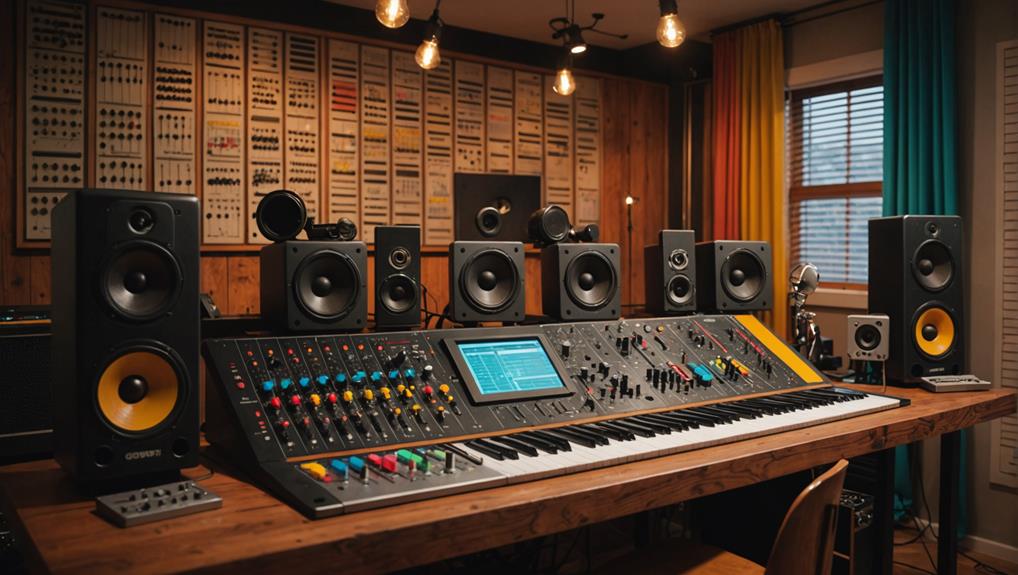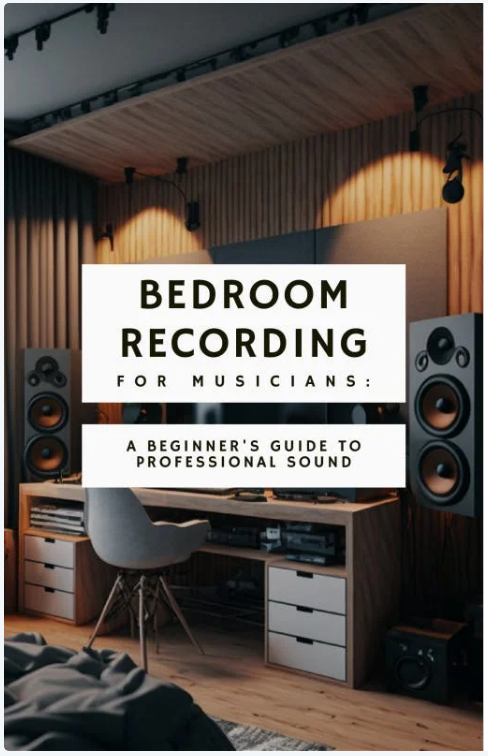To mix like a pro in your home studio, you need a solid grasp of sound fundamentals and advanced techniques. Start by managing your dynamic range with compression and adjusting EQ to prevent overlapping frequencies. Use automation for nuanced volume changes and to highlight emotional moments. Create depth by utilizing various reverb types and delay effects, ensuring they complement your mix without muddying the clarity. Focus on balancing vocals and rhythm sections carefully for a polished output. By mastering these techniques, you'll elevate your sound considerably. There's much more to explore that can refine your mixing skills.
Key Takeaways
- Create an effective recording environment with sound treatment to ensure high-quality audio capture for your mixes.
- Utilize EQ to balance frequency ranges and eliminate muddiness by managing overlapping sounds, especially in the low-end.
- Implement dynamic range management through compression, adjusting attack and release settings for a polished and balanced mix.
- Apply automation to enhance emotional impact and control individual track elements, simulating natural dynamic changes throughout the song.
- Experiment with various reverb and delay types to create depth and space, enriching the overall sound landscape of your mix.
Understanding Sound Fundamentals
In the domain of audio production, understanding sound fundamentals is vital for achieving a polished mix. Sound is characterized by frequencies, ranging from 20 Hz to 20 kHz in human hearing. This frequency range guarantees that each element in your audio mixes can be perceived clearly.
Effective recording environment and treatment plays an important role in achieving ideal sound quality. When you manipulate these frequencies using EQ, you can emphasize or reduce specific pitches, allowing melody and harmony to shine through.
Dynamic range is another important aspect; it refers to the difference between the quietest and loudest parts of your track. Mastering this dynamic range can considerably impact the emotional and musical expression of your mix.
In fact, when mixing, you need to guarantee that prominent elements, like melody, stand out against the backdrop of other sounds.
Essential Mixing Techniques
In your mixing process, mastering key EQ principles is essential for achieving clarity and balance among instruments.
You'll also need to manage dynamic range effectively, ensuring that every element sits well in the mix without overpowering others.
Key EQ Principles
Mastering EQ is fundamental for achieving a polished mix, as it allows you to sculpt the frequency spectrum precisely to enhance clarity and balance.
When mixing music, understanding the key principles of EQ can dramatically improve your results. Here are three vital considerations:
1. Identify Overlapping Frequencies: Recognizing where instruments clash in the frequency spectrum is essential. Cut frequencies in the mid-range to reduce muddiness, allowing each element to shine.
Utilizing essential mixing workflow tips can further enhance your EQ decisions.
2. Manage Low-End Frequencies: The low end can easily become overwhelming. Use high-pass filters to eliminate unnecessary low-frequency rumble from vocals and instruments, ensuring a cleaner sound.
3. Reference Professional Mixing: Regularly compare your mix to professionally mixed tracks. This practice provides insight into effective EQ decisions and helps you achieve that commercial sound.
Dynamic Range Management
Effective dynamic range management is crucial for achieving a well-balanced mix that retains both clarity and impact. Dynamic range refers to the difference between the quietest and loudest parts of your audio signal. To manage this effectively, compression becomes your primary tool. By reducing the volume of loud sounds while boosting quieter ones, compression guarantees a consistent overall level in your mix.
Additionally, mastering techniques such as equalization for tonal balance can complement your dynamic range management efforts.
Understanding the attack and release settings of your compressor is important. A fast attack will catch peaks, preventing them from overwhelming your mix, while a slow release allows the natural dynamics to flow back in, maintaining musicality.
Incorporating sidechain compression can also be a game-changer. This technique creates space in your mix by temporarily lowering the level of competing sounds, like the bass or kick drum, allowing elements such as vocals to shine through prominently.
Lastly, regularly referencing your mix on different playback systems will help guarantee that your dynamic range translates well across various listening environments. This practice is crucial for maintaining the emotional impact you intend, guaranteeing your mix resonates with listeners.
Effective Automation Strategies
Automation plays a pivotal role in shaping a mix's dynamics, allowing you to manipulate various parameters like volume and effects with precision. Effective automation strategies can enhance your audio mixing process, providing dynamic control that elevates your tracks.
Here are three essential mixing tips to reflect upon:
- Choose the Right Automation Mode: Familiarize yourself with automation modes in your Digital Audio Workstation (DAW), such as Read, Write, Touch, Latch, and Trim. Each mode offers unique advantages for tailored adjustments.
- Emphasize Key Elements: Use automation to highlight specific musical phrases or shifts. By guiding the listener's attention, you create an engaging experience that draws them deeper into the mix.
- Implement Subtle Volume Changes: Subtle volume automation can simulate natural crescendos and diminuendos, adding depth without overwhelming your mix. This technique guarantees clarity, allowing critical elements to shine through at pivotal moments.
Incorporating these strategies won't only help you achieve balance but also enhance the emotional impact of your music, making your mix resonate more profoundly with listeners.
Creating Depth and Space
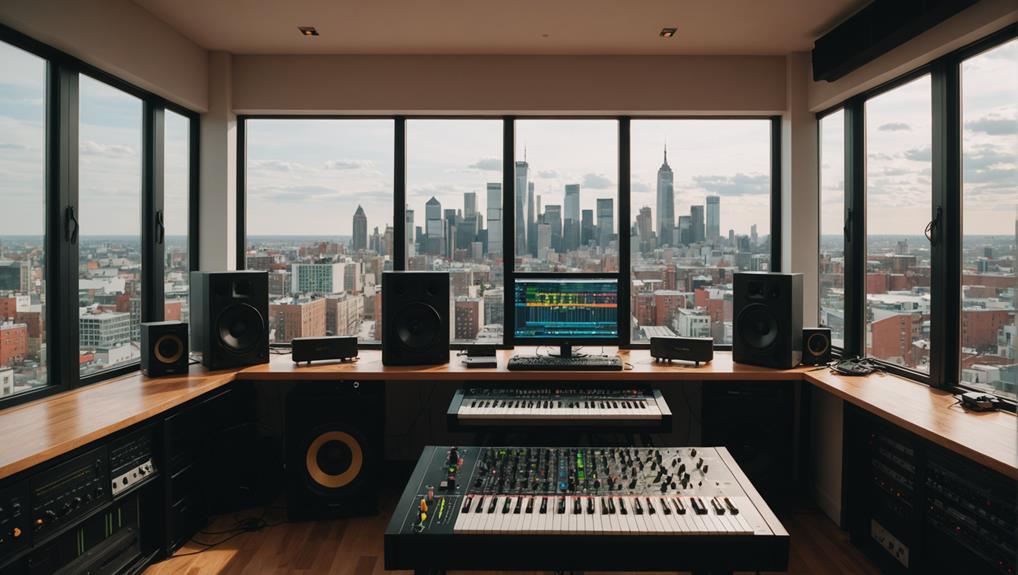
To create depth and space in your mixes, you need to explore various types of reverb, such as plate, hall, and room. Each type offers distinct characteristics that can greatly enhance your sound landscape.
Additionally, incorporating delay effects allows for rhythmic movement, enriching the dynamic stereo field and providing further dimensionality to your tracks.
Reverb Types Exploration
Four primary types of reverb—plate, hall, room, and spring—each bring unique characteristics that can dramatically influence the depth and spatial perception of your mix. Understanding these reverb effects is essential for achieving the desired ambiance.
- Plate Reverb: Known for its smooth and dense sound, it's ideal for vocals and snare drums, adding richness without overpowering the mix.
- Hall Reverb: This type creates a larger, more ambient sound, making it perfect for orchestral instruments and atmospheric pads, enveloping them in a lush soundscape.
- Room Reverb: Offering a more intimate sound, it simulates smaller spaces, adding warmth to acoustic instruments and enhancing their presence in the mix.
Each reverb type also features adjustable decay times, allowing you to fine-tune how long the effect lingers.
Additionally, pre-delay settings let the initial dry signal shine through before the reverb kicks in, maintaining clarity while enhancing the sense of space.
Delay for Dynamics
Delay is a powerful tool in your mixing arsenal that can greatly enhance depth and spatial perception. By simulating natural reflections found in various environments, you can enrich the overall soundscape of your mix. Different types of delay, such as tape or ping-pong, provide unique rhythmic patterns that contribute to diverse textures, making your track more engaging.
Adjusting the feedback levels on your delay effects is vital; it allows you to control how many repeats you hear. This can create either a subtle ambiance or a pronounced echo effect, depending on your artistic intent.
Additionally, incorporating pre-delay settings helps maintain clarity between the original signal and the delayed sound, ensuring your mix stays focused while gaining depth.
Synchronizing delay times to the tempo of your track is essential for achieving rhythmic cohesion. When delays are rhythmically integrated, they enhance the musical flow, making the effects feel like an organic part of the composition.
Working With Dynamics
Effective management of dynamics is essential for creating engaging mixes that resonate with listeners. By thoughtfully manipulating volume and intensity, you can breathe life into your tracks.
Here are three key strategies to enhance your dynamics:
- Compression: Utilize compression to tame loud peaks while elevating quieter sections. Mastering attack and release settings is critical; a fast attack controls transients, and a slower release allows for a more natural sustain.
- Automation: Implement automation to create dynamic changes throughout your track. This enables real-time adjustments that simulate natural crescendos and diminuendos, enhancing the emotional weight of your mix.
- Dynamic Range: Guarantee effective use of dynamic range to maintain clarity. By allowing all elements to coexist harmoniously, you prevent any single element from overpowering others, which is essential for mixing and mastering.
The Role of Frequency and EQ
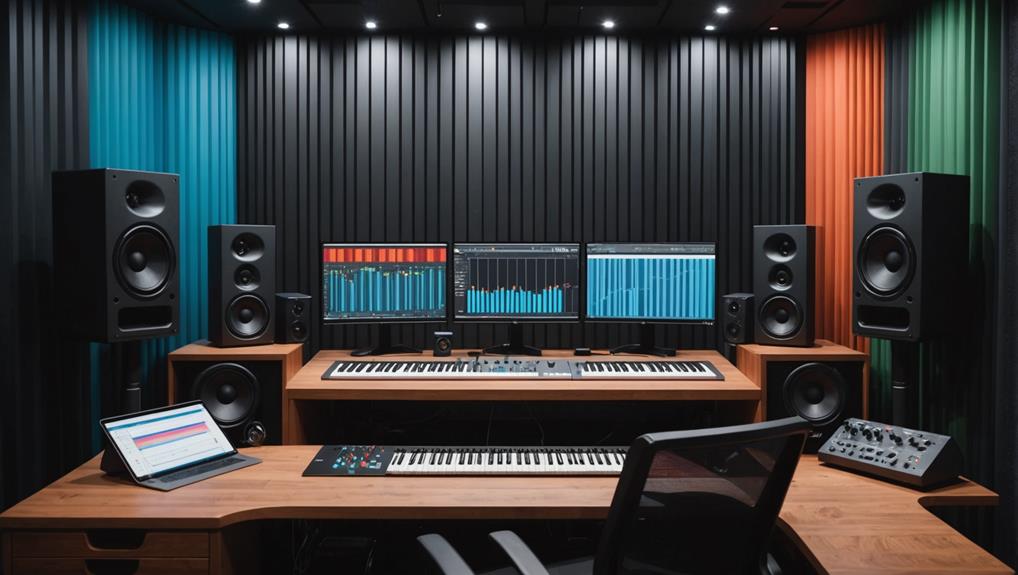
In the domain of audio production, frequency and EQ play pivotal roles in shaping the overall sound of your mix. EQ, or equalization, is an important tool that allows you to adjust the balance of specific frequency ranges in your audio tracks, enhancing clarity and character.
Mastering the various types of EQ—parametric, graphic, shelving, and dynamic—can greatly elevate your music production and mixing skills.
Identifying overlapping frequencies among instruments is essential; addressing these can prevent muddiness in your mix. For instance, applying high-pass filters can eliminate low-frequency rumble from vocals, while boosting high-mid frequencies can add presence and airiness.
It's crucial to strike a balance; effective EQ adjustments often involve cutting mid-range frequencies to enhance clarity, while carefully boosting lows and highs maintains distinct character for each instrument.
The Art of Vocal Mixing
When it comes to vocal mixing, achieving clarity and emotional resonance is paramount. To create a polished vocal track, you'll want to focus on several key techniques:
- Compression: This helps manage the dynamic range, guaranteeing that quieter parts are audible while preventing louder sections from overwhelming the mix.
- High-Pass Filtering: Remove unwanted low-frequency rumble by applying a high-pass filter, which enhances clarity without sacrificing warmth.
- Reverb: Use reverb judiciously to add depth, but remember to adjust pre-delay settings to maintain intelligibility of the lyrics while creating a sense of space.
Incorporating automation will allow you to make precise adjustments throughout the performance, emphasizing emotional shifts that resonate with listeners.
Proper gain staging is also essential; it prevents distortion and guarantees a balanced dynamic range, contributing considerably to your mix's overall polish.
Drums and Rhythm Section
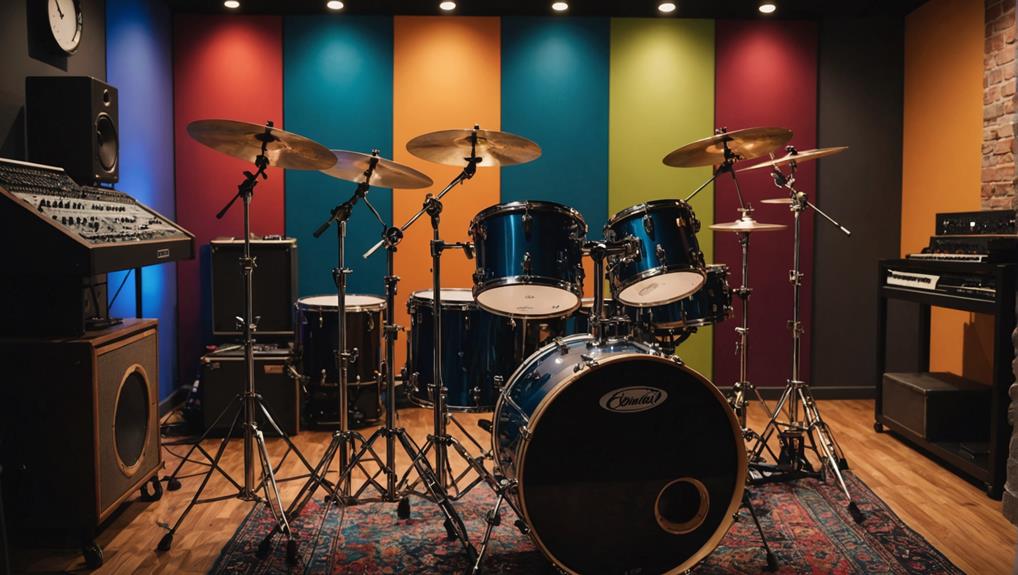
A punchy drum mix serves as the backbone of any track, driving energy and rhythm forward. To achieve this, you need to balance the kick drum and bass, ensuring low-end clarity without overwhelming the mix. Use dynamic processing techniques like compression to enhance the impact of your drums, providing them with presence and punch without squashing their natural sound.
Next, focus on your hi-hats and cymbals. Clear articulation is essential for establishing groove and maintaining energy. Careful EQ adjustments can prevent these elements from overpowering the rest of the rhythm section.
Pay attention to overlapping frequencies among your drums; applying mid-range EQ cuts helps each drum element retain its distinct character and prevents muddiness in the mix.
Lastly, consider stereo imaging techniques. Panning can create a wider soundstage, enhancing the depth and space within your rhythm section.
Mastering Your Mix
After you've crafted a punchy drum mix, the next critical phase is mastering your mix. This final step guarantees your track sounds cohesive and polished across various playback systems.
To achieve a professional sound, focus on these key techniques:
- Equalization: Balance the frequency content to enhance clarity. Pay attention to problematic frequencies that may muddy your mix.
- Dynamics: Use compression to control the dynamic range. This helps maintain impact and prevents distortion during playback.
- Loudness: Apply limiting to maximize loudness without clipping. This guarantees your track competes with professionally produced music.
Don't forget to use reference tracks. They serve as benchmarks for tonal balance and loudness levels, guiding your adjustments. A well-mastered track maintains clarity and impact, emphasizing dynamic control to avoid distortion.
Continuous learning and practice in mastering techniques are essential for honing your skills.
Developing a keen ear for audio quality will elevate your mixes, making them sound truly professional. Mastering isn't just a step; it's an art that can make all the difference in how your music is perceived.
Conclusion
As you step into your mixing journey, think of your tracks as a vibrant tapestry. Each element weaves together, creating a rich sonic landscape. By mastering sound fundamentals and employing essential techniques, you're not just mixing; you're painting with sound. Balance dynamics and frequencies like a skilled artist, bringing depth and space to your canvas. With practice, your mixes will resonate, echoing the clarity and emotion that only a true craftsman can reveal. Keep experimenting, and let your creativity flow.

